The Following Post was composed by respected scholar-danseuse Prakruti Prativadi.
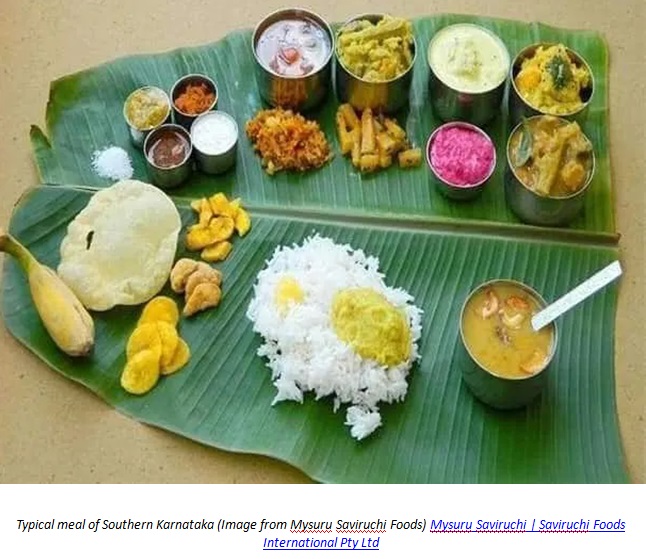
Discovering the cuisine of a land for oneself is much like solving a good mystery, every ingredient, dish and eating custom is a delicious clue. The cuisine of a land reveals much about her culture and the personality of her peoples; what they hold in regard and dear, their daily practices, the climate in which they live and even their history. Culture is embedded in food, food preparation, how it is served or eaten and food is a means of communication through generations. The memory of an entire people and their samskriti can be embedded in their cuisine. Our Indian cuisine takes this a step further since Indians have observed that guna-s and bhava-s are also embedded in food and the way its prepared.
The cuisine of Karnataka embodies this ethos as her plethora of dishes demonstrate. In this post, we begin an exploration and introduction into the vegetarian cuisine that is distinctive to the state. This post is by no means an exhaustive cataloguing of Karnataka’s vegetarian cuisine, as that would require several encyclopedic volumes, however gentle readers will be given a glimpse into the state’s rich variety and taste. Not coincidentally, two encyclopedic treatises have been written on Kannada cuisine. Manasollasa by the King Someshvara III is a monumental work cataloguing the culture and life of Kannada people and written in Samskritam. This work is from the 12th century therefore making it older than the earliest cookbooks of Europe. The work is 100 chapters with 20 devoted to food. Someshvara III was a king of the Kalyani Chalukyan empire in Karnataka and he devoted a large section of the book to the food and cuisine of Kannada people.
Remarkably, this work mentions dishes such as dose (erroneously called dosa by some), idli, vade and mosuru vade (vade dipped in yogurt) which are still in vogue in today’s homes and restaurants. Manasollasa describes the manners and etiquette prevalent at that time as well. One notable custom this work has recorded is the practice of keeping a clean cotton cloth on one’s lap while eating, revealing that the use of dinner napkins, as we call them today, was common in India prior to its use in the West.
The other work, Soopa Shastra by Mangarasa III written in Halegannada (Old Kannada) in the 15th century is a veritable recipe treasure trove and contains health and nutritional aspects of ingredients and recipes. Interestingly, Mangarasa’s treatise contains only vegetarian dishes, demonstrating vegetarian cuisine and vegetarianism are deeply entrenched in the lives of Kannadiga-s and Kannadathi-s.
Gentle readers need not despair, even the most ardent trencherman will be overwhelmed with the astonishing diversity within the vegetarian cuisine of Karnataka. This diversity cannot merely be attributed to differences in regions and sampradaya-s since these contain diverse variations themselves. The cuisine reflects the ayurvedic principles of healthy and harmonious food as well as the myriad of wholesome dishes that have organically become a part of the cuisine and not due to fads or trendy movements. This post will focus on home-cooked food found in many homes in Karnataka, and that has given inspiration to many a hotel menu too.
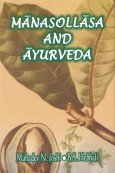
And while this introductory post will not go into the principles of Ayurveda with regard to food, it’s important to note that in Indian food, there are 6 flavors as opposed to the four (sometimes five) flavors in Western cuisine. The six Indian flavors are madhura (sweet), amla (sour), lavana (salty), katu (pungent), tikta (bitter) and kashaya (astringent). The four flavors that western cuisine has identified are sweet, salty, sour and bitter. Recently, the western cuisine adopted an additional flavor called ‘umami’, borrowing from Japanese cuisine and meaning savory. An ayurvedic rule is that all 6 flavors should be included in every meal and many dishes contain multiple flavors. Other ayurvedic principles are to avoid snacking between meals (which the west has now adapted and labeled intermittent fasting), make lunch the heavier meal of the day, and have a light dinner since it’s the meal toward the end of the day and therefore will be difficult to digest when taken right before sleep. Kannada cuisine has incorporated these flavors and principles in most of its dishes, making for an interesting culinary experience.
For instance, according to ayurveda, honey should never be boiled or cooked because doing so changes its structure and is harmful to the body. This principle is followed in Indian dishes that use honey. However, we find recipes in other cuisine cultures of the world wherein honey is baked or cooked.
The cuisine of Karnataka features mostly light, non-fried dishes in meals. Fried dishes comprise mainly snacks and street food.
The food also takes much from ayurvedic principles of health and well-being; with food ingredients being carefully chosen for those suffering from ailments. Indeed, the home remedies for colds, headaches, sore throats among others are derived directly from ayurvedic texts that have found their place in daily dishes of Karnataka. As an example, if one feels a cold coming on, the house will fill with the aroma of menasina saaru. An interesting aside: Menasina Saaru (ಮೆಣಸಿನ ಸಾರು) is the original Mulligatawny soup; the British appropriated the Tamil name ‘Milaga Thani’ which became anglicized to ‘Mulligatawny’ and the rest as they say is (revisionist) history. Menasina Saaru(ಮೆಣಸಿನ ಸಾರು), is very effective in battling colds and apart from being absolutely delicious, contains black pepper along with coriander seeds which are wonderful for clearing up a cold and one’s sinuses. There’s no need to wait to catch a cold to enjoy Menasina Saaru (ಮೆಣಸಿನ ಸಾರು), however, as it can be enjoyed even when one is hale and hearty.
Vegetarianism in Karnataka is quite common and dates back to the Vedic period. Many sampradaya-s,such as Lingayat-s, some Gowda-s, Madhva-s, Smartha-s, SriVaishnava-s, Vaishnava-s, Saraswat-sand Jaina-s to name a few follow vegetarian diets. These vegetarians comprise a significant percent of the state’s population.Contrary to erroneous Indological narratives, vegetarianism is not the domain of only Brahmana-s, as the aforementioned list of diverse groups shows; and as this author has seen herself.
The oft-asked question of whether these people chose vegetarianism due to religious or ethical reasons is specious and misleading, since in the Hindu and Jaina ethos, religion, ethics and spirituality are not mutually exclusive and are intertwined with one another. Most Indian vegetarians have chosen this diet because of ethical and moral reasons. Traditionally, non-vegetarians also eschew beef, as a gesture of compassion toward the cow since the cow is the embodiment of a mother and the divine, giving us milk as a mother does to her child. Thus, Indian vegetarianism is different in many ways from the modern vegetarian/vegan movements that started some 100 years ago in the West.
Another interesting note: Indians who are vegetarian/vegan adhere to this diet all of the time, sans “cheat days”. Contrast this in the West, where vegetarianism/veganism is still relatively new, and many vegetarians and vegans often have “cheat days” i.e., days in which they do eat meat. This author has friends who aren’t of Indian origin, have enthusiastically adopted the vegetarian or vegan diet and have a day or two in the week for “cheat days” when they can eat meat. This is understandable, as Western food does not lend itself to a vegetarian diet since it has not developed this diet in a natural manner over centuries and lacks nutritional completeness for which Indian vegetarian cuisine is known. The western approach to vegetarian/vegan foods is substitute plant-based alternatives of the original meat dishes. This approach has left western vegetarians sometimes feeling that the dishes are less than filling and flavorful and has nutritional gaps compared to the original non-vegetarian versions. For instance, protein, an important nutrient for all human diets, is of major concern in Western vegetarian diets because the protein in Western cuisines are usually found in the meat part of the dish only. Finding protein-rich vegetarian substitutions for meat is often a challenge in most Western vegetarian/vegan recipes.
However, in Indian vegetarian cuisine, the protein is spread throughout the dishes in the forms of lentils, legumes and yogurt and then paired with rice, wheat or millets. The protein content of lentils is twice that of wheat, barley and oats. Lentils combined with wheat or rice are a complete protein because they provide all the required essential amino acids to constitute a complete protein. Lentils contain vitamin B, dietary fiber and iron and other minerals needed for children, vegetarians and women of child-bearing years. Interestingly, one of the most folate-dense foods are cooked lentils. Folate is an essential nutrient for prenatal health for the developing fetus and to prevent many types of birth defects. As an example, below is the nutritional content of uddina bele (urad dal) and togari bele (toor dal), which are staples of Karnataka cuisine. Karnataka meals are replete with lentil dishes like nucchinunde, tovve-s and saaru-s, the latter two are customarily combined with either rotti-s or rice.
Millets also are high in protein, a variety of Ragi (finger millet) dishes are famous throughout Karnataka. Many gentle readers can relate to the constant inveighing and concern claiming vegetarians don’t get enough protein, vitamins and nutrition. As we can see, this narrative is false with regard to the Indian vegetarian diet which has organically developed and existed over millennia to accommodate the nutritional requirements of Indians of all ages.
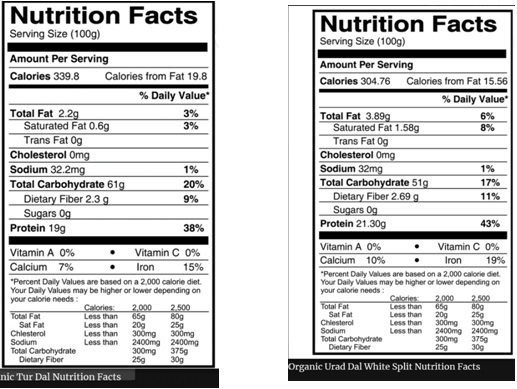
The famous idli and dose (sometimes erroneously called dosa) dishes have significant proportions of urad dal, which as seen above is high in protein. The other ingredient in idli and dose is rice – hence satisfying the lentil and rice combination to make up a complete protein! So, go ahead gentle reader, tuck into those fluffy idli-s or crisp masala dose-s without the self-loathing or fear that you might not be getting enough protein.
Indians are vegetarian for many different overlapping reasons, namely for a more sattvik diet, non-injury to animals, it’s better for the earth, and mainly as a sense of dharma. On festival days, many non-vegetarian Indians adhere to vegetarian diets as well.
Many temples all over Karnataka serve free sattvik vegetarian food (called prasada). Shri Kshetra Dharmashala serves from 30,000 to 70,000 devotees a day with a free annaprasada which is a 3 course meal here and all are welcome. Even in a small village, this author has visited temples that serve free prasada to all bhakta-s. Urban area temples also have this practice.
Akshaya Patra, an initiative of ISKCON, which feeds about 1.8 million children throughout India, serving the nutritional complete vegetarian midday meals at their schools. This initiative was started in Bengaluru, Karnataka.
This has an analogous practice in homes in Karnataka as well, traditionally in many Karnataka homes no one would eat until an outside guest was first served the meal and ate. This tradition dates back centuries and is still in practice in some rural towns. Even in urban Bengaluru, this custom was alive and well in this author’s grandparents’ homes.
Many Hindu-s offer the food to the divine, prior to eating. Each family or sampradaya has its own shloka and ishta devata and method in which the food is offered. Food that is offered is sattivik and freshly cooked.
To kick-off this culinary adventure, let’s begin with a typical home-cooked meal which overlaps the food served on many festival days.
Palya-s(ಪಲ್ಯ):
Palya (ಪಲ್ಯ) is the first course of a meal whether it is an elaborate wedding meal or a home-cooked one.
Local vegetables are used in palya-s; making them a healthy and nutritious starter. Many local veggies like, thondekayi (ತೊಂಡೆಕಾಯಿ), heerekayi (ಹೀರೆಕಾಯಿ), badanekayi (ಬದನೆಕಾಯಿ), bendekayi (ಬೆಂಡೆಕಾಯಿ), beans (ಹುರಳಿಕಾಯಿ) and even spinach and leafy greens are used to make these dry curries which are often flavored with their own specific spice mixtures (pudi-s (ಪುಡಿ)). These spice pudi(ಪುಡಿ)combinations are well guarded secrets having been passed down from generation to generation. Palya-s are a natural side dish to either rotti or rice.
Kosambri: A nutritious dish with raw vegetables and hesaru bele (mung dal). A staple of most meals.
Gojju-s (ಗೊಜ್ಜು):
Gojju(ಗೊಜ್ಜು): is a unique Karnataka dish with multiple variations and cooked with a variety of vegetables. Gojju usually isn’t on the menu in most restaurants or hotels as it is a characteristic home-cooked experience and somewhat complex to make. Gojju-s can be made with either a grated coconut and spice blended mixture (wet mixture) or a pre-made pudi (ಪುಡಿ) spice mixture (dry mixture). Gentle readers, be forewarned, you take your life in your hands if you ever ask for either spice mixture recipe, as these are well guarded secrets unique to each home and passed down from generation to generation. Whether made with the wet or dry spice mixture, gojju-s are delicious, containing at least 5 of the 6, or in the case of some gojju-s all of the 6 flavors resulting in a delightful burst of flavors with each bite. Gojju-s are customarily eaten with either rotti-s or rice.
Tovve (ತೊವ್ವೆ): A cooked lentil dish and garnished with oil, mustard seeds, asafoetida and chili peppers. This is eaten with rice.
Saaru and Huli (ಸಾರು/ಹುಳಿ): Paired with rice and the main part of a southern Indian meal. Lentils are cooked with vegetables and tamarind and spices are mixed together. Saaru is thinner and Huli is more robust.
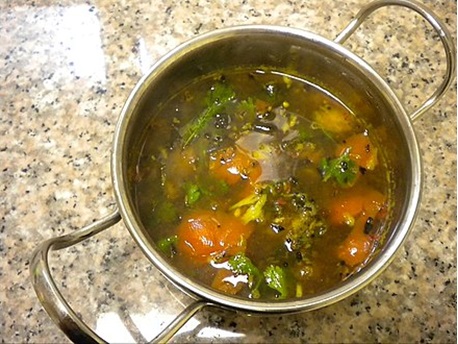
Rotti-s (ರೊಟ್ಟಿ): (Prounounced ro-tee with a short o)
Gentle readers may be surprised to know that Karnataka has several distinct rotti recipes and rotti is indeed popular in the state’s cuisine thus routing the “Rotti is mainly eaten in northern India and southern Indians eat only rice.” stereotype.
North Karnataka is famous for Jolada rotti made out of Jolada hittu (sorghum millet flour) which is rich in protein. Jolada rotti and badanekayi (eggplant) palya is a mouth-watering combination.
Other popular rotti-s are:
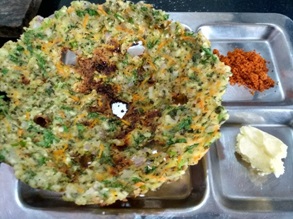
Akki Rotti (ಅಕ್ಕಿ ರೊಟ್ಟಿ):
Ragi Rotti (ರಾಗಿ ರೊಟ್ಟಿ):
and the ever-popular godi rotti.
Rice dishes:
Puliyogare (ಪುಳಿಯೋಗರೆ) is a dish that was invented in Melkote Karnataka by Melkote Sri Vaishnava-s. Puliyogare enjoys immense popularity especially in the old Mysuru state regions (the old Mysuru Kingdom which includes Bengaluru, Mysuru, Mandya, Hassan, Chikkamagalur, Udupi, Dakshina Kannada, Chamarajanagara and Kodagu). The word Puliogare is a Halegannada (Old Kannada) word: ‘Puli’ means tamarind in Halekannada and ‘Ogare’ means seasoned rice dish. Melogare is another Kannada dish and there are a variety of Ogare dishes in Karnataka. Ogare and Melogare have been mentioned in several old Kannada cooking treatises. Mangarasa himself mentions a tamarind rice dish in his work Soopa Shastra. For those who have spent a lot of time or have grown up in the southern part of Karnataka, Puliyogare is well-known. Its popularity has spread in recent times and it is specially prepared as prasada in temples, on festival days and eaten day-to-day in homes.
Chitra anna: A famous Kannada dish that has several variations; its made of garnished rice, peanuts, flavored with lemon juice, cilantro and curry leaves.
Other rice dishes include: Badanekayi chitranna (spicy dish with eggplant and rice) and mavinkayi chitranna(mango chitranna) are popular thindi-s (light meals) and are mentioned in old Kannada cuisine treatises such as Mangarasa’s Soopa Shastra.
Huggi: A rice and mung dal dish, this dish is mentioned in Magarasa’s Soopa Shastra as well.
Bisi bele hullianna (ಬಿಸಿಬೇಳೆಹುಳಿಯನ್ನ): The original Kannada name of this dish is not‘Bisi Bele Bhaath’ which is what it later came to be called when popularized in hotels. Bisi bele hullianna is an iconic dish from Karnataka and requires grinding coconut with its own secret roasted spice mixture which is mixed with cooked rice. The recipes for bisi bele hullianna vary. The only vegetable traditionally used for this dish is avarekallu, which is very popular in Karnataka. Dishes using other vegetables are just not considered authentic by purists. Sorry gentle readers, we did not make the rules.
Payasa-s: This sweet dish is served in the middle of the meal, it serves to cleanse the palette for the second half of the meal. It is shastra to serve payasa in the middle of the meal.
Shavige Payasa:
Made with shavige (vermicelli) and milk with cashews and raisins as garnish. A staple at most festivals.
Other popular payasa-s are gasagase payasa which is unique to Karnataka and ksheeranna made by cooking rice in milk.
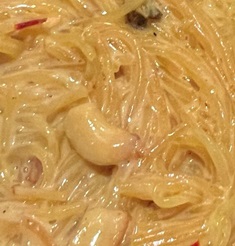
Mosuru Vade(ಮೊಸರು ವಡೆ): Vade dipped in a garnished yogurt mixture; omit sprinkling it with masala and boondi for an authentic Karnataka taste.
Mosuranna(ಮೊಸರನ್ನ):Garnished yogurt rice; sometimes garnished with cashews. Yogurt rice, whether garnished or plain, is the customary end of every southern Indian meal as it aids digestion and is soothing for the stomach. Interestingly, Manasollasa specifically mentions that a meal should end with yogurt rice
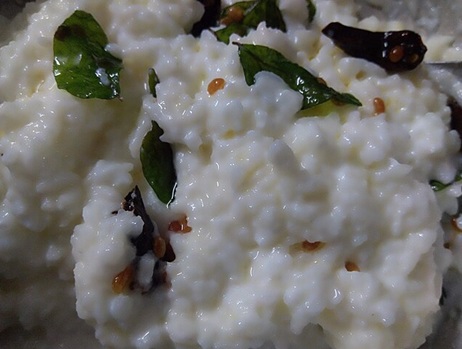
A few other popular dishes in Karnataka cuisine:
Sajjige (ಸಜ್ಜಿಗೆ): the original name for Kesari Bhaath. Made from rave and sometimes with pineapple, a delicious breakfast or thindi.
Other favorite sweet dishes include kajjaya, sajjappa and kobri mittai.
Obbattu, (ಒಬ್ಬಟ್ಟು)and Holige (ಹೋಳಿಗೆ): A dish made with maida filled with ground lentils or coconut and jaggery. A festive dish and staple for festivals. Yet another dish that finds mention in Manasollasa.
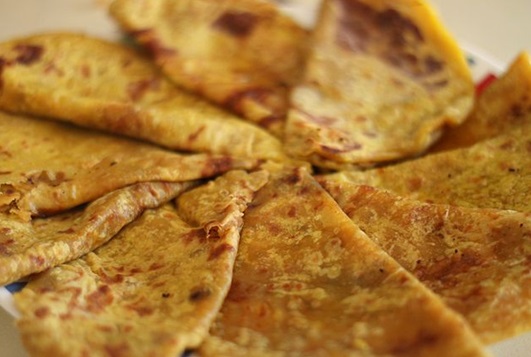
Obbattu (ಒಬ್ಬಟ್ಟು) served warm with ghee (ತುಪ್ಪ)
Mysore Pak (ಮೈಸೂರು ಪಾಕ್):This is a one of a kind and famous sweet invented under the patronage of the Wadiyars. There are 2 types of Mysore Pak(ಮೈಸೂರು ಪಾಕ್): one version being softer and the other with more textures. The textured variety requires more skill and practice to master.Note: Mysore Pak (ಮೈಸೂರು ಪಾಕ್) is most definitely not like a cookie.
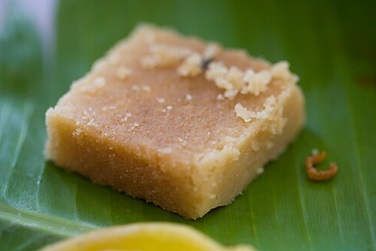
Mysore Pak, an iconic dish of Karnataka
Halbayi (ಹಾಲುಬಾಯಿ): A delicious age-old sweet made from rice and jaggery.
Akki Halbai | Rice Halbai | Akki Manni Recipe | How to prepare Halbai – YouTube
Majjige huli (ಮಜ್ಜಿಗೆ ಹುಳಿ): Made with boodukumbalakayi (winter squash) and yogurt and spices. A warm dish full of nutrition and delicious enough to eat as a soup, especially on cold days.
Ennegayi (ಎಣ್ಣೆಗಾಯಿ): A healthy and mouth-watering dish from northern Karnataka made of eggplants stuffed with a special masala. This goes really well with jolada rotti (ಜೋಳದ ರೊಟ್ಟಿ).
Ennegayi recipe | badanekai yennegai |Stuffed Brinjal | Uttara Karnataka Style ennegayi – YouTube
Menasina saaru (ಮೆಣಸಿನ ಸಾರು): the aforementioned ayurvedic-inspired dish that helps with colds and sinus trouble.
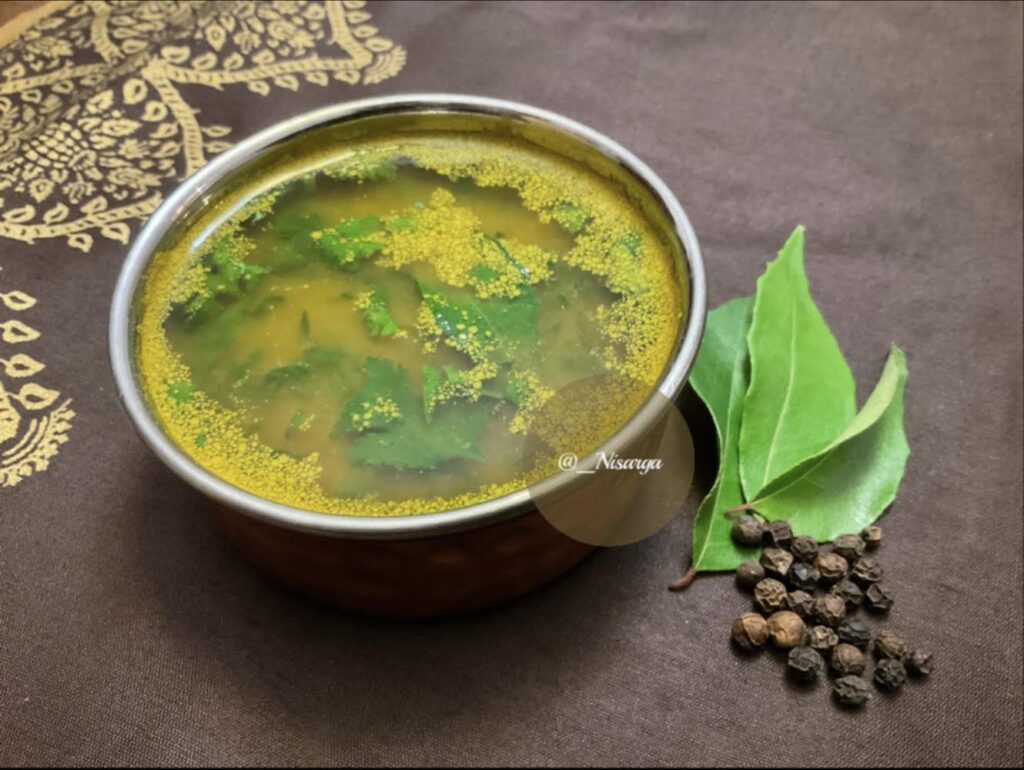
Nuccinunde (ನುಚ್ಚಿನುಂಡೆ): A healthy dish consisting entirely of togari bele (ತೊಗರಿ ಬೇಳೆ)(toor dal), coconut, cilantro, green chilis, garnished and spiced. Full of protein and nutritional value. Nuccinunde(ನುಚ್ಚಿನುಂಡೆ) can be eaten alone or with majjige huli or served with chutney for a delicious meal in and of itself.
Sihi and kaara kadabu (ಸಿಹಿ/ಖಾರ ಕಡಬು): The prasada offered to Ganesha especially during Ganesh Chaturthi. In Karnataka its usually made in both a sweet and savory version.
Sihi Kadubu | Sweet Kadubu | Avi Kadubu with jaggery | Gluten free sweets – YouTube
Pathrode (ಪತ್ರೋಡೆ):This is a tasty Mangaluru and Konkani delicacy made from colocasia leaves, masala paste, steamed and pan fried.
Pathrode / Konkani Style Colocasia Leaves Pathrode Recipe with Tips to Prevent Itchiness – YouTube
Ragi Mudde (ರಾಗಿ ಮುದ್ದೆ): a hearty and healthy dish, rich in protein and usually paired with huli(ಹುಳಿ).
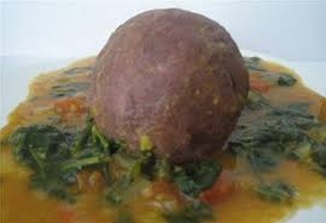
Vade (ವಡೆ): There are a variety of vade-s enjoyed in Karnataka cuisine. Apart from the common uddina vade, there is also ambode and the famous Madduru vade (ಮದ್ದೂರು ವಡೆ)from Madduru (ಮದ್ದೂರು) Karnataka, which now enjoys state-wide popularity.
Photo: Wiki Commons
The famous Madduru Vade(ಮದ್ದೂರು ವಡೆ), from Madduru Karnataka
Puri Palya: Puri paired with a potato palya is a popular dish in Karnataka homes.
Chutneys: a large variety of chutneys abound and are usually served with idli-s, vade-s and dose-s and even some rice dishes.
Idli: The earliest ever work to reference Idli is ‘Vaddārādhane’ in Halegannada and written by Shivakoti Acharya in the present-day Bellary district of Karnataka. In this work, Shivakoti Acharya mentions ‘iddalige’ with the same ingredients as today’s idli. The dating of this work is between the 2nd and 9th century CE. Furthermore, the Halekannada work Lokopakara by Chavundaraya II (circa 1025 CE) describes the preparation of ‘Iddarika’; and the aforementioned Manasollasa by Someshvara describes the making of ‘Iddalige’. The ingredients and preparation are almost identical to today’s idli and scholars state they are one and same dish, thus showing idli’s origins are firmly inside of India and rebutting the specious and baseless speculation that the origin of idli lies elsewhere.
Rave Idli: Rave Idli’s origin unveils an important historical fragment of the land. Rave Idli was invented out of necessity by MTR, Mavalli Tiffin Rooms, in Bengaluru during World War II. The British placed heavy rationing on the important staple rice, a key ingredient in regular idli-s. Thus, the inventive folk at MTR created a new and instant idli dish using rave (semolina). Rave Idli is a healthy and popular dish even today. This piece of history exposes the extent of colonial interference in the day-to-day lives of ordinary Indians and the hardships Indian men, women and children faced during those times. Incidentally, these and other food restrictions imposed by the British caused the catastrophic Bengal famine of 1943 in which 3 million Indians died of starvation, as confirmed by historians.
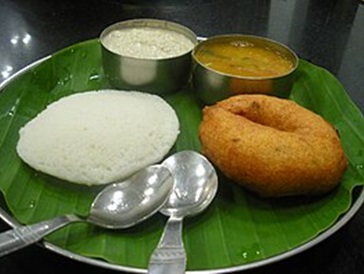
Idli with Vada, served with coconut chutney and saaru
Dose-s: Dose (pronounced like ‘though-say’) dates back to at least the 5th century AD if not earlier. The earliest recipe for dose is mentioned, once again, in Manasollasa by Someshvara III in the 11 century, thus once again firmly placing the origins of this versatile and famous delicacy in Bhaarat and not elsewhere. According to historian and researcher P. Thankappan Nair, the town of Udupi Karnataka, with its myriad temples and traditions, is the birthplace of dose. Masala dose is a famous dish of Karnataka which features a potato and onion palya tucked inside the dose and paired with chutney. Masala dose has become immensely popular outside of Karnataka in modern times.
Set dose: consists of 2 to 3 soft dose-s topped with butter and served with chutney, a favorite of children and adults alike, especially for breakfast.
Some other dose varieties include, neer dose, from Tulunad, and Davanagere benne dose from Davanagere, delicious alternate dose dishes should one ever tire of the others
Chiroti: A flaky and crunchy delicacy served by pouring hot kesari milk on  the chiroti and sprinkling with fine sugar (boora sakre, ಬೂರಾ ಸಕ್ಕರೆ) right before eating.
the chiroti and sprinkling with fine sugar (boora sakre, ಬೂರಾ ಸಕ್ಕರೆ) right before eating.
Snacks:
Churimuri: A street food like snack made with puffed rice and chopped onion, tomato and cilantro.
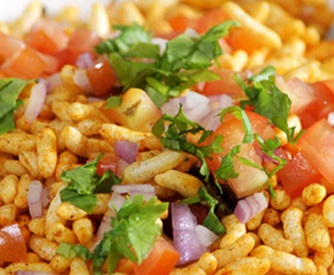
Other snack items are hurukadle, kodbale, pakoda, chakli and a variety of uppitu-s.
Happala, sandige, pheni (ಹಪ್ಪಳ/ಸಂಡಿಗೆ/ಫೆಣಿ): there are numerous varieties of these crunchy accompanying dishes; they are some of the many sides eaten with rice meals.
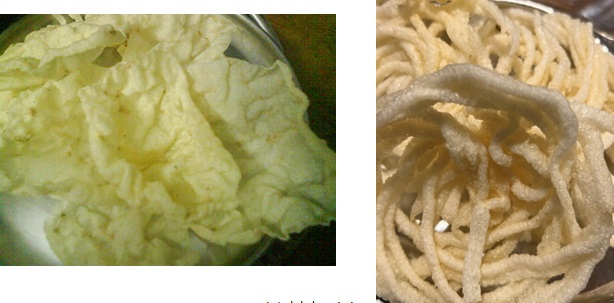
Happala(ಹಪ್ಪಳ) and pheni (ಫೆಣಿ)
Uppinakayi (ಉಪ್ಪಿನಕಾಯಿ) – These are the myriad pickles made with the fruits and vegetables local to the state. They are too many to enumerate; mango, lemon and roots of medicinal plants are commonly enjoyed. Usually relished with mosuranna, dose and idli.
Coffee and Tea are popular in Karnataka. Mysore filter coffee is delicious and Koorg is known for its rich coffee plantations.
Drinks: there are a variety of healthy and delicious drinks from Karnataka. Badami milk and Ragi malt are both nutritious and popular. A myriad of fruit juice drinks with ayurvedic properties abound made with local fruits.
This has been a mere introduction to the varied and versatile vegetarian cuisine of Karnataka. This post is by no means exhaustive and numerous delicious dishes have been omitted, in no way due to their lack of significance but due to the scope of this post which prevents their inclusion. Gentle readers will no doubt want to try out some or all of these dishes for themselves and further explore the many delicacies Karnataka has to offer.
References:
- Achaya, K.T. Indian Food: A Historical Companion. Oxford University Press 1994
- Nair, Thankappan, P. The History of South Indian food in Kolkata, Punthi Pustak 2004
- That perfect food companion for long journeys, Puliyogare (newskarnataka.com) retrieved July 24, 2023
- Puliyogare | Karnataka Tourism retrieved July 24, 2023
- Mallik S. Colonial Biopolitics and the Great Bengal Famine of 1943. GeoJournal. 2023;88(3):3205-3221. doi: 10.1007/s10708-022-10803-4. Epub 2022 Dec 6. PMID: 36531534; PMCID: PMC9735018.Retrieved July 24, 2023
- Samaranayaka,Chapter 11 – Lentil: Revival of Poor Man’s Meat,Editor(s): Sudarshan R. Nadathur, Janitha P.D. Wanasundara, Laurie Scanlin,Sustainable Protein Sources,Academic Press,2017,Pages 185-196
- Shrigondekar, G. K., Manasollasa of King Somesvara, Baroda Oriental Institute, 1939
- Jois, S.N. (Editor), Supa Shastra of Mangarasa (Science of Cooking), Institute of Kannada Studies, University of Mysore, 1969
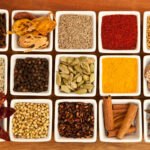
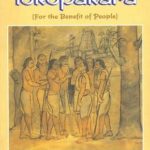
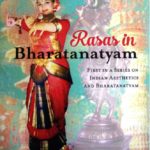
Highly informative, authentic extremely well written supplemented with mouth watering photos of the dishes. Great work. Congratulations and thanks.
ಧನ್ಯವಾದಗಳು 🙏
Thanks for the informative and mouthwatering article. Readers are advised not to read this in the midst of an ekadasi fast
The tie in to ayurveda was great. I did not know about the historical cook books! I would love to get my hands on those. Looking forward to more articles of this nature.
This is a very informative and interesting article. I love how the author explains differences between vegetarianism in India and vegetarianism in the west, and does not jumble them into one category. I also like how cultural appropriation is mentioned, as this is not a regularly discussed topic. Thank you 🙏🏽